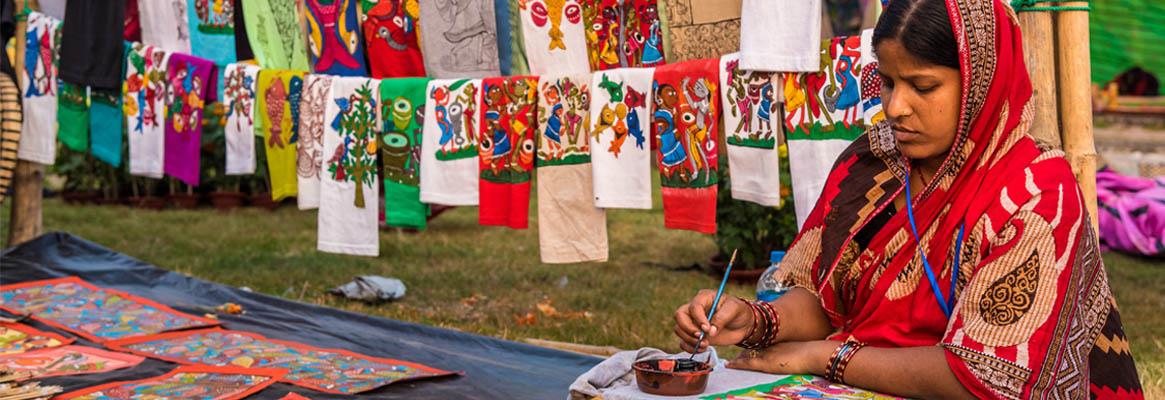Historically, being a painter or a stamp artist did not mean you could become a textile artist, says John Miller.
The Textile art has not been explored thoroughly. It does not actually require you to be skilled in painting or adept at critical and creative hand movements. It is entirely something else. Much like today's artisans across the world, this was an art passed from one generation to the next. Therefore, it is a heritage where threads were dyed on a large scale in a wide variety of colours, and all of them from natural sources. Highly skilled weavers who were a part of this creative business were often father and son teams.
So what is textile art? To answer that, let us go back a few centuries because textile art as we know it has a long history of men and women practicing it across generations. This is not just a painting or printing job but something more elaborate.
The ancient Egyptians made gorgeous textiles and in China, certain types of clothing have been found that date back thousands of years. Countless artists specialised in making textiles but they are unknown to us today because all their creations, despite being intricately made, were meant for everyday use. We often just saw what they made, but did not always know their names.
A tapestry is textile art. In ancient times, it was seen as a very large weaving made solely by hand, preferably on a vertical loom. Imagery or scenes on a tapestry would be narrative or decorative. Early tapestries had a basic and predefined purpose: Insulation. These large works of fine fabric were used for hanging on castle walls, and protected inhabitants from damp and cold weather. Flanders, in the northern Belgium, was a hub of tapestry manufacturing in medieval times.
So, textile art is a form that involves creating something using fibre, fabric, thread and natural colours from sources like plants, animals and insects. It includes processes like weaving, sewing and embroidery and all this results in the creation of a rug, a colourful wall hanging, knitting and crochet patterns and other handmade items of clothing or sculptures made out of fabric.
A great example of such intricately made tapestries is the Lady and the Unicorn series. This is a set of six images that were woven out of wool and silk in Flanders around 1511. If you are an ardent history student or an ancient culture enthusiast, you must have come across books or stories about the Middle Ages that mention such artistic creations. Each creation is a little different from the other but features an elaborately clothed woman. A smiling, fanciful unicorn accompanies her with other creatures on a red background surrounded with foliage and other small animals.
Some handmade or woven goods or early textile creations are not tapestries, despite names like Bayeux tapestry. This is actually an elaborate embroidery piece. It is made of eight linen pieces sewn together standing about 231 feet long and almost 20 inches in height with elaborately embroidered images in eight colours of wool yarn. The Bayeux tapestry shows dramatic images of knights and horses, soldiers and combats, and narrates the Norman Conquest.
Today, craftsmen use different media with naturally derived dyes, inks and threads to express their creativity and originality in items such as handmade handbags, even block prints and handcrafted jewellery, crochet or knitting patterns for babies. The diversity of art and creativity has taken the world of textiles to new levels of popularity. According to studies, the textile industry in India alone provides almost half a million people with stable employment. In addition, a large number of artisans, artists, designers, block print makers, weavers, embroidery makers and packers are involved in the trade.
Hand printed textiles have become popular in both domestic and international markets. This includes block and screen printing and batik along with kalamkari, which is hand printing by pen, and bandhani (tie and die), the popular method of dyeing fabric.
Today, there are numerous techniques of producing beautiful and unique textile art products that range from bed covers and pillow cases to sheets, conventional dress materials to upholstery, crochet and knitting patterns and tapestries, demand for which has grown over the years. Nobody can argue against the popularity of the painstakingly embroidered articles of silk and cotton. These are often embellished with stones and glass gems, mirrors, pretty shells, beads and metallic pieces.
Textile art is not just a singular artistic field. It is a discipline that requires passion, dedication and commitment. If supported and encouraged, it can become a source of employment for thousands of families across the globe.
About the author:
John Miller has completed his MBA from Fairleigh Dickinson University. He is currently working as quality manager at Artisna Marketplace.











Comments